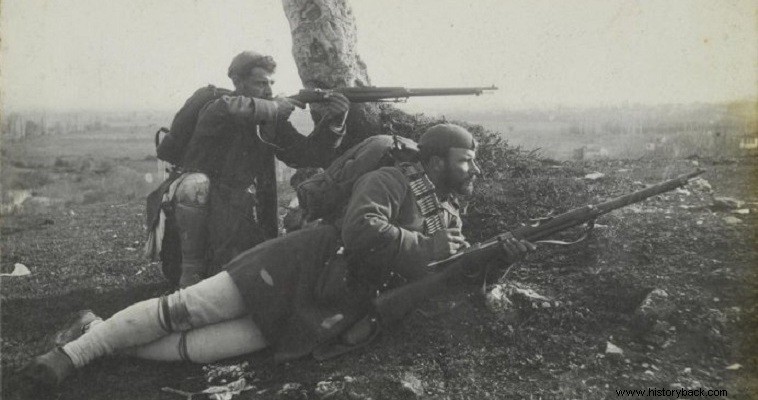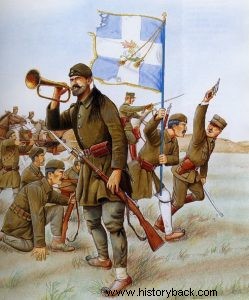
From October 5, 1912, Greece was at war with the Ottoman Empire. In the morning of the same day, the Greek forces crossed the border. A climate of restrained excitement prevailed as the soldiers released meter by meter of Greek soil. However, the memories of "black '97" did not allow, at least for now, the manifestation of unrestrained enthusiasm.
The Greek Army of Thessaly had taken up positions around the Damasian salient. On the far left, opposite Deskatis, the Evzone Detachment of colonel (MH) Stefanos Gennadis, with two Evzone battalions, had been deployed. The detachment formed the army's powerful bodyguard.
To the south, at the top of the eminence, the Cavalry Brigade, under Major General Alexandros Soutsos, based in the village of Zarko, was stationed. On the right side of the salient were the IV Infantry Division (MP), the III MP, the II MP and the Ezona Detachment of lieutenant colonel (MX) Konstantinos Konstantinopoulos. The I MP was positioned next to the II. Further back from the border, the V, VI and VII Infantry Divisions were positioned.
At first light on October 5th, the Greek forces crossed the border. Their vanguard clashed with the garrisons of the Turkish outposts and forced them to abandon their positions. The Turks put up weak resistance and, apparently by design, withdrew further north. By the evening the Greek forces, having lost 46 dead and wounded, had advanced along the salient of Damasio and had regained the old line of the border, as it was before 1897.
The next day the army continued the advance. The General Headquarters, to which all the divisions were directly subordinate, in its operations order for October 6, had ordered the capture of Elassona and Deskata. In front of the two towns the Turks had established themselves defensively, determined to defend them, although they did not have particularly strong forces.
For the attack against Elassona, the Commander-in-Chief, Crown Prince Konstantinos allocated the I, II and III MPs and the Evzone battalions of colonel Konstantinopoulos. However, in the absence of serious means of transmission and effective control of operations from the "overloaded" headquarters, the coordination of actions was not possible.
The Belt Detachment had not even received the operations order according to which it would come under the command of the I MP. He thus acted of his own accord, advancing north-east, and it was not until noon on the 6th of October that he connected with the division. But the battle of Elassona, the first of the war, had already been decided.
The 1st MP had earlier crossed the strait of Meluna and had advanced, with two regiments in the first echelon, towards the town. The Turks held the heights around the city by regimental strength. They also had artillery elements. The 1st MP, by 10.00, had moved to the village of Tsaritsani. There he also received the welcome of the Turkish artillery.
Its commander, Lt. Gen. Emm. Manousogiannakis, immediately ordered the deployment of the division in battle formation. To the left of I MP, II also moved towards Elassona when it too received enemy artillery fire. Immediately the division deployed in battle formation and attacked the enemy positions on Paliouri Hill. The Turks put up strong resistance this time. But they were not able to hold out for long.
Gradually, their resistance was reduced, both in the sector of the II MP, and in the sector of the I. The heights around Elassona were occupied by the Greek forces, who advanced to a distance of 7 km from the town, where they established outposts. The two Greek divisions suffered a total of 66 dead and wounded during the battle.
Turkish losses were also light. At the western edge of the front, the Gennadis Evzones Detachment had also launched against the Turkish positions on Mount Tretimos, south of Deskatis. The Turks had deployed defensively in the difficult terrain and faced the Greek attack with courage. The battle of Descatis was an infantry duel, a duel between the fortified Turks and the invincible Euzones.
The Euzonians prevailed and caused the Turks to flee disorderly, pursuing them at a distance of 8 km from their original positions. A little earlier, men of the detachment had entered Deskatis to the cheers of the inhabitants. The detachment's losses reached 19 dead and wounded.

Euzones set out. Painting by Stelios Nigdiopoulos.
